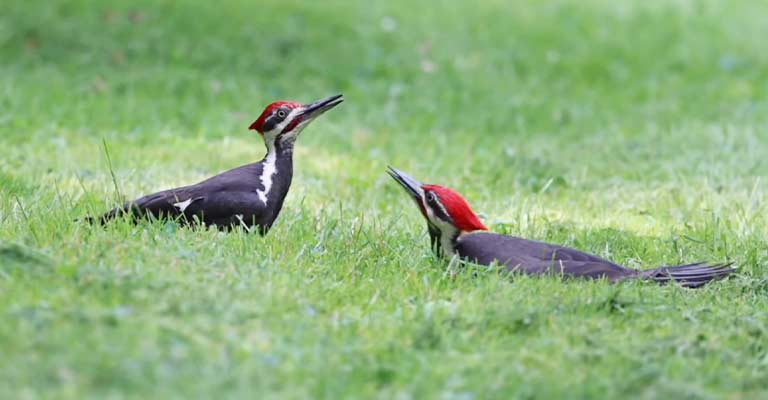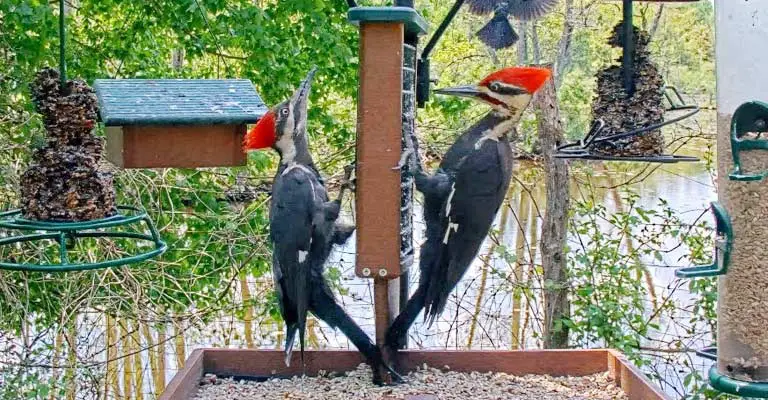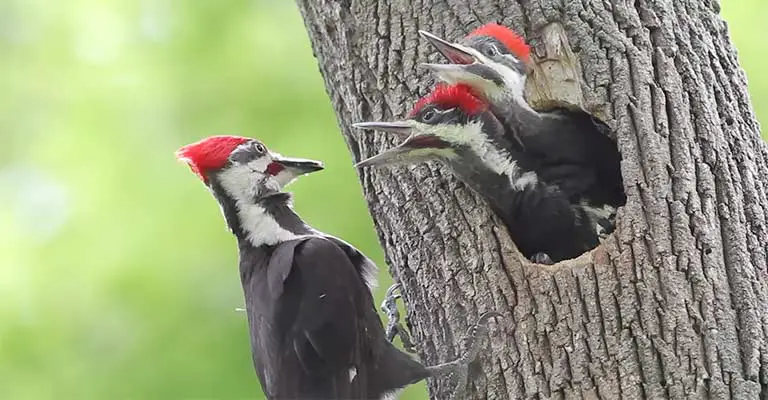Within the woodland symphony of courtship, Pileated Woodpeckers engage in an intricate ballet of behaviors, unfolding a captivating narrative of love and reproduction.
These majestic birds, with their striking red crests and resonant drumming, partake in a series of fascinating mating rituals.
From spirited drumming displays to vocal calls and tree-climbing acrobatics, the world of Pileated Woodpecker mating behaviors is both nuanced and vibrant.
This exploration unveils Pileated Woodpeckers Mating Behaviors that define their breeding season, offering a glimpse into the complex and elegant rituals that contribute to the continuation of their species.

Pileated Woodpeckers Mating Behaviors
In the intricate dance of courtship, Pileated Woodpeckers display a fascinating array of mating behaviors. From spirited calls to intricate displays, these majestic birds engage in rituals that signify the onset of the breeding season.
Delve into the captivating world of Pileated Woodpecker mating behaviors, where nature’s drama unfolds with grace and complexity:
Drumming Displays
Male Pileated Woodpeckers employ drumming as a key mating behavior. The rhythmic and resonant tapping on trees serves as both a territorial assertion and an attention-grabbing courtship display, showcasing the woodpecker’s strength and vigor to potential mates.
Vocal Calls and Communication
Pileated Woodpeckers engage in elaborate vocalizations during mating season. Both males and females use distinctive calls to communicate and attract mates. These calls, ranging from loud drumming to soft cooing, convey messages of courtship and connection.
Head-Throwing Gestures
A captivating behavior during courtship involves head-throwing gestures. Males, in particular, perform exaggerated head-throwing movements, showcasing their vitality and strength. This dynamic display is a visual cue to potential mates about their fitness as partners.
Tree-Climbing Acrobatics
Courtship often involves impressive tree-climbing acrobatics. Pileated Woodpeckers ascend tree trunks with agility, showcasing their prowess and stamina.
These aerial displays serve as both a demonstration of physical fitness and a means of attracting a mate.
Nest Excavation and Preparation
Part of the courtship ritual includes nest excavation and preparation. Pileated Woodpecker pairs collaborate in creating or modifying nesting cavities. This shared effort symbolizes commitment and signals readiness for the upcoming nesting season.
Mutual Feeding Rituals
Mutual feeding plays a crucial role in Pileated Woodpecker courtship. Mates share food items as a bonding gesture, reinforcing their connection and partnership. This behavior not only sustains the birds but also strengthens the emotional bond between potential mates.
Wing-Spread Displays
Wing-spread displays are striking courtship behaviors observed in both male and female Pileated Woodpeckers. Spread wings reveal bold white markings, creating a visually stunning spectacle. This display is a visual declaration of readiness for courtship and reproduction.
When Do Pileated Woodpeckers Mate?

The mating rituals of Pileated Woodpeckers unfold in a rhythm synchronized with the changing seasons. Understanding the timing of their courtship and mating provides insights into the intricate dynamics of these majestic birds’ reproductive cycles.
Late Winter to Early Spring
Pileated Woodpeckers typically initiate their courtship and mating rituals in late winter to early spring. During this period, as the weather begins to warm, these birds engage in vocalizations, drumming displays, and elaborate gestures to attract potential mates.
Territorial Announcements in Early Spring
In early spring, Pileated Woodpeckers intensify territorial drumming displays, signaling not only their readiness for courtship but also establishing and defending their nesting territories.
This behavior helps in attracting a suitable mate to share the upcoming breeding season.
Nest Excavation in Spring
As spring progresses, Pileated Woodpeckers embark on nest excavation activities. Pairs collaborate in finding or creating suitable nesting cavities. This nesting preparation is a critical aspect of their mating behavior, indicating the imminent arrival of the breeding season.
Mutual Feeding and Bonding in Spring
Spring sees an increase in mutual feeding behaviors as Pileated Woodpecker pairs strengthen their bonds through shared food resources. This collaborative feeding ritual enhances the connection between mates and prepares them for the responsibilities of raising offspring.
Egg-laying in Late Spring
Pileated Woodpeckers typically lay their eggs in late spring. After successful courtship, pairs select a nesting cavity, and the female lays a clutch of eggs. The exact timing may vary based on geographic location and environmental factors.
Incubation and Nesting in Early Summer
Early summer marks the incubation and nesting phase for Pileated Woodpeckers. Once the eggs are laid, the female diligently incubates them while the male assists in providing food. This period is crucial for ensuring the survival of the offspring.
Fledging and Parental Care in Summer
By mid to late summer, Pileated Woodpecker chicks hatch and eventually fledge. Parental care continues as the adults feed and protect their young. The summer months are a testament to the successful culmination of the mating process as the next generation of woodpeckers takes flight.
How Long Do Woodpeckers Babies Stay With Their Parents?

The duration of time that woodpecker babies, or fledglings, stay with their parents varies based on the specific species and environmental conditions.
Generally, woodpeckers invest a considerable amount of time and effort in raising their young. After hatching, the nestling period typically lasts several weeks, during which parents tirelessly provide food and protection.
Once the fledglings are capable of flight and have developed sufficient skills to forage on their own, they gradually become more independent. For some woodpecker species, this independence is achieved within a month or two after fledging.
However, during this initial period of independence, the young woodpeckers may stay near their parents, continuing to learn essential skills and receiving occasional assistance.
Ultimately, the exact duration of the parent-offspring association varies among woodpecker species, reflecting the unique behavioral adaptations of each.
FAQs
Do Pileated Woodpeckers engage in mutual feeding during courtship?
Yes, mutual feeding is a significant courtship behavior. Pileated Woodpeckers share food resources, reinforcing bonds between mates and preparing for the responsibilities of raising offspring.
What is the role of wing-spread displays in courtship?
Wing-spread displays are striking courtship behaviors that visually signal readiness for mating. Both males and females spread their wings, revealing bold white markings.
Why do Pileated Woodpeckers engage in nest excavation during courtship?
Nest excavation is a crucial courtship ritual as it symbolizes commitment and preparation for the upcoming breeding season. Pileated Woodpecker pairs collaborate in creating or modifying nesting cavities.
How do Pileated Woodpeckers communicate during courtship?
Pileated Woodpeckers communicate through elaborate vocalizations, ranging from loud drumming to soft cooing. These calls play a key role in courtship rituals, helping attract potential mates.
What is the significance of tree-climbing acrobatics in Pileated Woodpecker courtship?
Tree-climbing acrobatics showcase the woodpeckers’ agility and stamina, serving as both a demonstration of physical fitness and a means of attracting mates during courtship.
Conclusion
As the forest echoes with the rhythmic drumming and melodious calls, the mating behaviors of Pileated Woodpeckers reveal a captivating tapestry of nature’s intricacies.
From mutual feeding rituals to acrobatic displays, each behavior serves a purpose in the intricate dance of courtship.
The resilience, grace, and adaptability showcased in these mating behaviors underscore the significance of these majestic birds in sustaining their lineage.
Through the lens of their courtship rituals, Pileated Woodpeckers remind us of the timeless wonders embedded in the natural world, where love, survival, and the perpetuation of life intertwine in a harmonious ballet beneath the forest canopy.